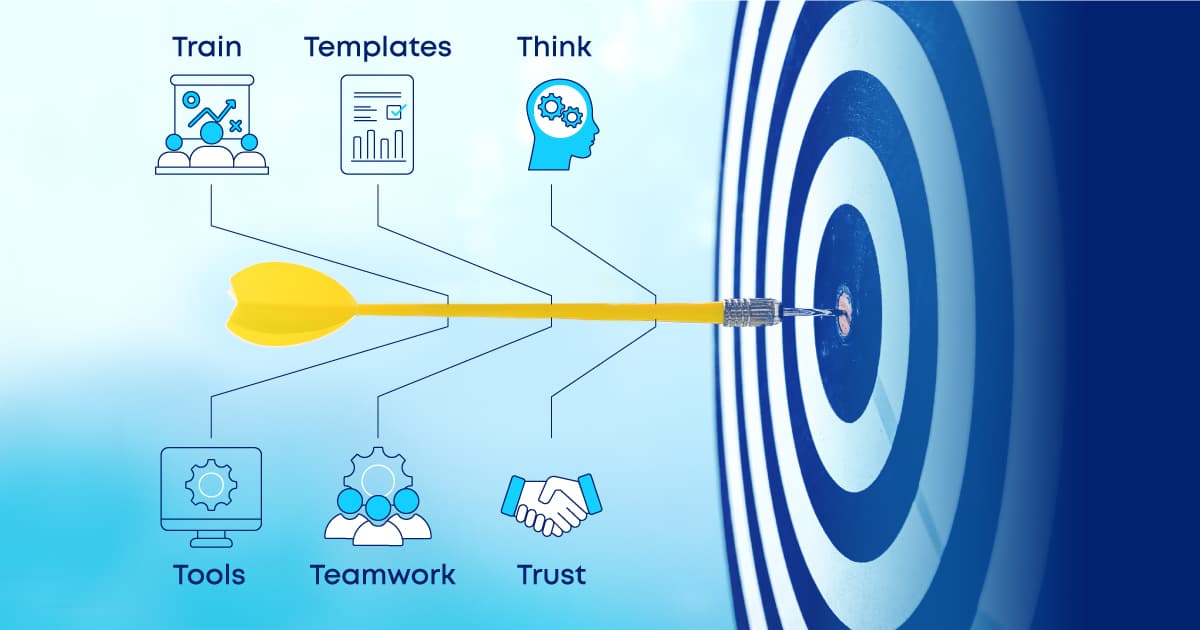If computer software assurance is the next evolution in validation, why haven't more companies abandoned traditional computer system validation (CSV) and adopted a full CSA approach? This question has been on the minds of many life sciences industry professionals. While CSA offers numerous benefits and improvements to the software validation process, several factors may be contributing to the slower adoption rate.
One reason could be the perceived complexity and challenges of adopting a full CSA approach. Implementing CSA requires a shift in mindset and changes in processes, procedures, and how teams collaborate. It may require additional training, resources, and investments, which some companies may hesitate to undertake without a clear understanding of the potential return on investment.
However, despite these short-term challenges, we cannot ignore the long-term benefits of CSA. CSA offers a more comprehensive and proactive approach to software validation, focusing on critical thinking, risk assessment, and efficient testing methods. It enhances the quality and reliability of validation efforts, reduces the likelihood of errors and noncompliance, and ultimately improves patient safety.
Now that we've explored the concept of CSA and its benefits, let's examine what constitutes a sound CSA adoption strategy.
The 6 Ts of CSA Adoption
We have simplified the process of adopting CSA into six key elements, which we call the "6 Ts" — Think, Train, Templates, Trust, Teamwork, and Tools. We'll discuss these elements individually, beginning with the importance of critical thinking.
#1. Think Critically
Critical thinking plays a pivotal role in the realm of computer software assurance. It is a skill that you should use consistently, not only before and after adopting a CSA program but also throughout its entire lifecycle.
Before implementing CSA, all stakeholders must understand and agree on its definition and approach. This includes quality assurance, IT, validation engineers, and system users.
When writing standard operating procedures (SOPs), remember to allow room for interpretation. Empower users to tap into their own critical thinking abilities. Use SOPs as a guide for risk assessment and potential testing. However, avoid imposing too many hard and fast rules that must be strictly followed.
Create a CSA Playbook
Before adopting your CSA program, create a CSA playbook. This is important for two reasons:
- The playbook will formulate how you apply CSA within your organization.
- The playbook can be shared with auditors and clearly outlines how CSA will be followed at the site.
The amount of information you decide to include is up to you. However, avoid copying and pasting your SOPs in their entirety into the playbook. Instead, include only the essential elements that describe how you follow a CSA approach.
Share Your CSA Playbook with Auditors
As your CSA program matures, you will become less reliant on the playbook, but its value will remain significant. Sharing the playbook with auditors will help them understand how you've applied CSA principles to validation. This should result in fewer observations and smoother audits.
Evaluate Risk and Test Methods (Scripted vs. Unscripted Testing)
Critical thinking is crucial for assessing and mitigating risks during the CSA process. This involves identifying risks, conducting risk assessments, and taking steps to lower them. Additionally, it is essential to consider how to test, whether through scripted or unscripted testing.
In general, the FDA advises us to reserve scripted testing for high-risk features and systems. Unscripted testing is the way of the future, allowing us to save valuable time and resources. It encourages us to depend less on scripted testing and predetermined protocols and more on existing test/vendor records and automated tools in our testing efforts.
A misconception exists that the purpose of CSA is to eliminate traditional computer system validation (CSV) and scripted testing. This is false. The true purpose of CSA is to remind us to use critical thinking with a risk-based approach to determine the system features most crucial to product and patient safety and focus our most rigorous testing efforts there.
Reflect on Lessons Learned
After you've gone through the entire CSA lifecycle, it's important to reflect on what happened, i.e., what was successful and what failed. We want to learn from our past experiences to improve our processes and enhance the efficiency and quality of our validation efforts in future CSA exercises.
#2. Train Stakeholders
To make your CSA program effective, everyone involved must be trained and fully understand how to follow the CSA approach.
End-Users
End-users should understand the CSA playbook, SOPs, how to assess and mitigate risk, and when to use unscripted testing. It is also vital to teach end users how to collaborate with different user groups (validation, IT, quality, business owners, and system owners) involved in the CSA process.
Quality Team
Quality must understand how you apply the CSA playbook and assess risk. They must also recognize that unscripted testing does not imply undocumented testing. It simply means that the level of documentation required is significantly less than what is typically needed for traditional scripted testing. Teach them to focus on the quality of testing, not the quantity of documents produced.
Auditors and Inspectors
When training auditors and inspectors, do not focus on teaching them your CSA approach. Instead, focus on teaching them how to use your CSA playbook effectively. This ensures they understand how you have implemented CSA, ultimately leading to a reduction in 483 observations and smoother audits.
#3. Use Templates
Well-defined templates aid in the adoption of your CSA program. They facilitate collaboration, simplify communication, enhance efficiency, and incorporate best practices.
Promote Consistency and Standardization
Templates promote consistency and improve quality by providing a standardized format for documents. This ensures that documents have a consistent appearance and structure, making it easier for users to navigate and understand the information they contain. Regardless of who the author is or who executes the protocol, templates ensure that documents look similar from one user to the next.
By maintaining a consistent format, templates also help to streamline the review and approval process. Stakeholders can quickly and easily locate the information they need, reducing the time and effort required for document review. This improves efficiency and helps prevent errors or omissions that can occur when data is scattered or presented in different formats.
Simplify Knowledge Transfer and Training
Furthermore, templates serve as a valuable tool for knowledge transfer and training. New team members can refer to existing templates to understand the structure and content requirements for different types of documents. This helps them quickly get up to speed and ensures they follow the CSA process correctly.
In addition, templates can be continuously improved and updated based on lessons learned from previous CSA exercises. As new best practices emerge or regulatory requirements change, templates can be revised to incorporate these updates. This ensures that documents remain up-to-date and aligned with current standards.
Don't overlook the value of templates. If stakeholders find your templates easy to use, they'll also find your CSA process easy to follow.
#4. Trust Stakeholders
Trust is not only a crucial factor in successful CSA adoption but also the foundation upon which the entire process is built. Without trust, the CSA approach cannot flourish and yield the desired outcomes.
Validation Engineers and IT
First and foremost, trust between validation engineers and IT is essential. It is imperative to have confidence that these individuals have been adequately trained in the standard operating procedures (SOPs) and possess the necessary skills to navigate the CSA playbook. Trusting their critical thinking abilities and the results they provide is vital for the overall success of the CSA process. Collaboration and effective communication between validation engineers and IT are crucial for thorough system testing and accurate documentation of objective evidence.
Vendors
Trust in vendors is equally important. It is essential to rely on the comprehensive testing conducted by vendors on their platforms. By leveraging their documentation, particularly for regulations like 21 CFR Part 11, organizations can avoid redundant testing and streamline the validation process. Trusting vendors' testing and incorporating it into protocols can significantly reduce the burden of exhaustive testing and ensure that the focus remains on essential aspects of product and patient safety.
Quality Team
Trust also needs to extend to the quality team. Quality personnel should be trained in the SOPs and familiar with the CSA playbook. They must understand how CSA is applied and focus on the quality of testing rather than the quantity of documentation. Shifting the validation approach from a document-centric mindset to a testing-oriented one requires trust in the quality team's ability to effectively adapt and embrace this new approach.
Project Team
Lastly, trust within the project team is paramount. All team members should be trained in the SOPs and possess a comprehensive understanding of the CSA approach and playbook. Trusting the project team's competency and ability to navigate the CSA process ensures everyone is aligned and working together toward a common goal.
While trust cannot be easily measured or quantified, it is integral to successful CSA adoption. Trust fosters collaboration and a shared commitment to product and patient safety.
#5. Build Teamwork
Teamwork is another essential component of CSA adoption and is closely tied to trust. Here are a few strategies to foster teamwork and collaboration within your CSA process.
Involve Stakeholders Early
It is vital to involve all relevant parties early in the process, including IT, business and system owners, process owners, quality assurance, and even development teams. By embracing a collaborative approach, we can drive effective teamwork throughout the entire process.
Host Interactive Sessions
When you involve stakeholders, hosting interactive sessions is always a good idea. If we gather input from a diverse group of individuals who can offer their expertise, it will significantly enhance the overall quality of our testing, validation, and, specifically, our CSA approach. By including a wide range of perspectives, we can expect significant improvements in these areas, ultimately leading to better outcomes.
Work with Developers to Resolve Defects Quickly
Finally, it is crucial to involve developers in the CSA process. By working closely with developers, we can achieve a higher quality system, as any issues can be promptly addressed and resolved. This collaboration between validation engineers, CSV professionals, and developers ensures that the CSA approach aligns with the Agile methodology, where end-user feedback significantly enhances product quality.
#6. Leverage Tools
The FDA CSA guidance encourages the use of technology. Integrating automated testing tools into your testing process allows you to quickly execute regression tests whenever necessary or when changes occur. This not only improves efficiency but also guarantees comprehensive and precise testing. With automated testing tools at your disposal, you can streamline your validation efforts and optimize the overall quality of your products.
Automation tools have made significant advancements and continue to evolve, making it easier to create automated test scripts without being a coder. Today's tools allow you to drag and drop elements to create test scripts.
Additionally, research is being done on natural language processors that use AI technology to generate test scripts based on the tests you want to perform. This advancement in automation tools and AI will significantly impact how we leverage the CSA approach and manage validation in the future.
(To delve deeper into this topic, explore our 2-part blog series, Generative AI and Its Impact on Validation.)
ValGenesis VLMS is a Purpose-Built, CSA-Ready Solution
Lastly, it's essential to use a tool that has been purpose-built to meet the demands of CSA, such as the ValGenesis Validation Lifecycle Management System (VLMS). Our VLMS allows you to enforce technical controls that ensure your CSA process is followed correctly.
The system is equipped with comprehensive risk management capabilities. You can configure it to mirror your processes, allowing it to automatically calculate risk and determine the level of testing needed to mitigate that risk.
The ValGenesis VLMS is also the first solution to support unscripted testing. The capability to manage unscripted test cases is critical for successful CSA adoption. Any solution that lacks this capability is NOT CSA-ready.
As more success stories and case studies emerge from companies that have embraced CSA, the adoption rate is likely to increase. Embracing the CSA approach now will position you far ahead of your competitors, providing you with a significant edge in the industry.
Watch the "6 Ts to CSA Adoption" webinar for a deeper dive into the 6Ts.



-What-Are-Assurance-Needs.png)